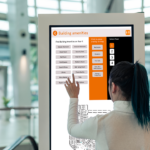Airports are dynamic hubs of activity, travelers buzzing from terminal to terminal where a plethora of languages can be heard, styles seen, and unique experiences shared. Efficient management and communication are crucial in these smart-city settings, ensuring smooth traveler experiences for everyone. The adoption of data-centric models has revolutionized airport operations, offering a comprehensive approach to managing resources, enhancing communication, and optimizing traveler experiences. A consolidated DCMS has helped pave the way for many airports, integrating systems and connecting crucial touch points that enhance the passenger journey.
Understanding Data-Centric Airport Models
Data-Centric Airport Models represent a paradigm shift in airport management, leveraging data to drive decision-making processes and enhance operational efficiency. At its core, a data-centric airport integrates critical systems and technologies to collect, analyze, and utilize data efficiently. By consolidating the systems into one management platform, airports are presented with a single pane of glass, a blank canvas in which they can create an entire ecosystem of communication. By strategically placing digital signage throughout the airport, travelers receive real-time updates, wayfinding directions, emergency alerts, and even notifications about which line is shorter to go through TSA.
Benefits of Consolidated DCMS
“When travelers have information at their fingertips, they are better equipped to make decisions that positively affect their journey throughout the airport,” notes Celso Rodriguez, Solutions Consultant for Smart Airports. Whether it’s information about which carousel their baggage will be at, the concession stand with the shortest wait time, or wayfinding to get them to their gate, we want travelers to have real-time, visualized information from arrival to departure.”

Celso Rodriguez, Solutions Consultant for Smart Airports
Visualized Data Touchpoints
Digital signage serves as a dynamic communication platform, delivering real-time updates and notifications to travelers. Whether it’s information about gate changes, flight delays, or security wait times, digital signage ensures that travelers are kept informed throughout their journey. Moreover, visual cues provided by digital signage can help streamline traveler flow, directing them to shorter lines or alternate routes, thereby reducing congestion and enhancing efficiency.
Enhanced Traveler Experience
Consolidated DCMS goes beyond mere communication by enhancing traveler experiences through personalized recommendations and increased awareness of amenities. By analyzing traveler data and preferences, airports can deliver tailored recommendations for dining, shopping, or entertainment options within the airport premises based on historical data and predictive analytics. Additionally, digital call-outs highlighting local amenities and services can guide travelers towards a more enjoyable and convenient experience during their layovers or transit.
Efficient Workflow Management
Integrating various systems within a consolidated DCMS enables airports to streamline workflow management and resource allocation. By aggregating data points, airport operations is able to make informed decisions on optimizing staffing levels, anticipate peak times, and allocate resources more effectively. This proactive approach to workflow management not only improves operational efficiency but also enhances overall traveler satisfaction by reducing wait times and bottlenecks.
Future Trends and Considerations
Looking ahead, the future of data-centric airport models is filled with exciting possibilities. Emerging technologies such as artificial intelligence, machine learning, and the Internet of Things (IoT) are poised to further revolutionize airport operations and traveler experiences. However, as airports continue to leverage data to enhance efficiency and convenience, it’s essential to prioritize data privacy and security to maintain traveler trust and confidence.
Data-Centric Airport Models, coupled with a consolidated DCMS and integrated digital signage, represent a game-changer in airport management. By harnessing the power of data, airports can improve communication, enhance traveler experiences, and streamline workflow management, ultimately leading to more efficient and enjoyable journeys for travelers worldwide. As we embrace future trends and innovations, the vision of a seamless and connected airport experience is within reach, promising a brighter future for travelers and airport operators alike.











